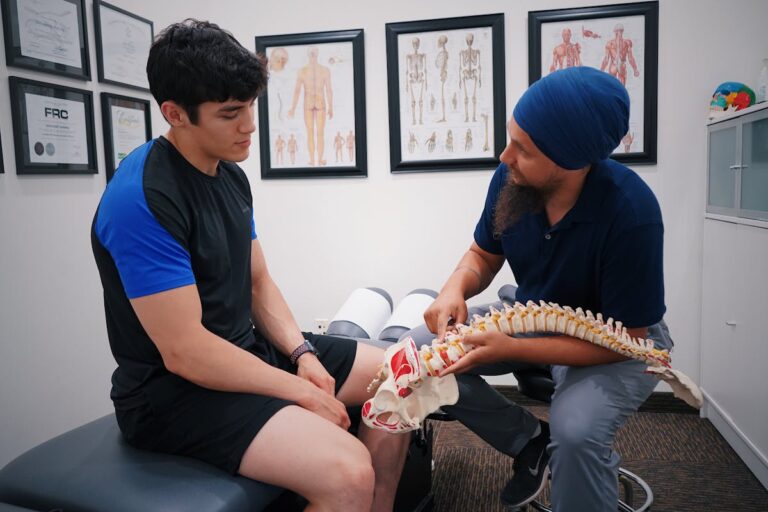Chiropractic care can potentially impact arthritis, a common condition causing joint pain, inflammation, and stiffness. Unlike conventional treatments which often involve medication and surgery, chiropractic methods offer a non-invasive alternative. The key techniques, spinal manipulation and joint mobilization, may influence arthritis progression and symptoms. This treatment’s mechanisms, benefits, risks, and role in arthritis management are worth exploring and understanding.
Understanding Arthritis: An Overview
Arthritis, a complex disorder, is not limited to the elderly but affects all ages. It’s characterized by joint inflammation and degeneration causing discomfort and disability. Its onset results from factors such as genetic predisposition, environmental triggers, and lifestyle choices, including smoking and obesity. In certain cases like rheumatoid arthritis, an abnormal immune response triggers it.
Symptoms of arthritis encompass joint pain, swelling, stiffness, and reduced motion range. These symptoms vary in intensity and can remain constant or change over time. As arthritis progresses, visible permanent joint changes may occur, such as knobby finger joints. However, arthritis can also impact the heart, eyes, lungs, kidneys, and skin, showing symptoms beyond joint discomfort.
Understanding causes and symptoms paves the way for exploring effective treatments like chiropractic care for managing this debilitating condition.
Basics of Chiropractic Care
Chiropractic care, a non-invasive treatment, targets the musculoskeletal and nervous systems, chiefly the spine. Established in 1895 by D.D. Palmer, this method hinges on the body’s self-healing capacity without drugs or surgery. Chiropractic philosophies vary, focusing on aspects from spinal adjustments to holistic care, including lifestyle modifications and environmental factors. For arthritis sufferers, chiropractic care can manage pain and optimize body structure-function relationships, particularly in the spine, enhancing life quality. Despite not curing arthritis, chiropractic care significantly eases discomfort, highlighting its importance in understanding arthritis treatment.
How Chiropractic Treatments Work
Chiropractic treatments function by centering on the body’s musculoskeletal structure alignment, especially the spine, to potentially benefit arthritis patients. This process involves various techniques underpinned by supporting evidence.
Chiropractic Techniques for Arthritis
Chiropractic techniques, such as gentle spine and joint manipulations, are effective for arthritis treatment. They realign the body, restore movement, reduce joint inflammation, and improve flexibility. Regular chiropractic sessions can maintain joint health and prevent further degeneration. The duration and frequency of treatment are personalized based on arthritis severity and patient response. The ultimate goal is pain management, function improvement, and life quality enhancement for arthritis patients.
Understanding Chiropractic Effectiveness
The effectiveness of chiropractic treatments for arthritis rests on the principles of natural recovery and inherent healing. Contrary to common myths, patient testimonials validate the treatments’ efficacy.
- Chiropractic methods target joint inflammation, a key arthritis symptom.
- Spine manipulation by chiropractors enhances joint mobility, reducing pain and stiffness.
- These treatments boost blood circulation, facilitating natural healing.
- Chiropractic therapies rectify body misalignments, reducing pain and improving functionality.
- They also support a healthier, active lifestyle, advantageous for arthritis sufferers.
A thorough, objective comprehension of these points highlights the potential of chiropractic care in treating arthritis.
Potential Benefits of Chiropractic for Arthritis
Chiropractic care’s potential arthritis benefits are manifold. Key techniques like spinal manipulation and mobilization may lessen joint inflammation and enhance physical function. We will succinctly examine these benefits, focusing on their mechanisms and overall health impact.
Chiropractic Techniques for Arthritis
Chiropractic techniques offer potential arthritis relief by targeting joint inflammation and mobility. Despite arthritis prevalence, the efficacy of these methods is disputed. Techniques include:
- Spinal manipulation for joint flexibility enhancement
- Mobilization techniques to mitigate joint stiffness
- Low-level laser therapy targeting pain reduction
- Ultrasound therapy for cell regeneration stimulation
- Nutritional advice for inflammation management
These methods may relieve symptoms and improve life quality, but are not a cure. Further research is required for evidence-based chiropractic arthritis treatment confirmation.
Reducing Joint Inflammation
Chiropractic care can effectively reduce arthritis-induced joint inflammation. This approach enhances wellness through lifestyle modifications, comprising diet and exercise. Consuming a balanced diet rich in anti-inflammatory foods and engaging in regular physical activity can diminish inflammation and bolster joint mobility. Chiropractors typically advise on dietary and exercise habits to bolster overall health, often recommending exercises to fortify muscles near affected joints, thereby alleviating strain and inflammation. Maintaining optimal weight through diet and exercise can lessen pressure on weight-bearing joints, further curbing inflammation. Thus, chiropractic care is integral in managing arthritis symptoms.
Risks and Considerations in Chiropractic Care
Chiropractic care, while beneficial, comes with risks and considerations. Concerns primarily surround safety protocols, practitioner training rigor, and chiropractic controversies.
Notably, chiropractic effectiveness and safety are debated, suggesting its potential unsuitability for all patients. Patient safety hinges on practitioners adhering to established guidelines, reducing instances of adverse effects from improper technique or errors.
Certain health statuses, such as osteoporosis or inflammatory arthritis, necessitate cautious approach to chiropractic care to avoid exacerbating these conditions. Practitioner competence influences complication risks, making their experience and qualifications crucial.
Lastly, chiropractic procedures can cause discomfort or pain, making it essential for patients to communicate their pain tolerance levels with their chiropractors.
Chiropractic and Osteoarthritis: A Connection
The link between chiropractic care and osteoarthritis requires concise, clear, and purposeful examination. Initially, it’s crucial to comprehend osteoarthritis as a degenerative joint disease. Subsequently, the evaluation of varied chiropractic treatments, their potential benefits, and risks, help determine their efficacy for osteoarthritis.
Understanding Osteoarthritis
Osteoarthritis, a degenerative joint disease, results from joint cartilage breakdown, causing pain and stiffness. Diagnosis involves physical examination, patient history, and imaging tests such as X-rays or MRI. Management includes lifestyle modifications to reduce joint strain, enhance mobility, and maintain a healthy weight. This encompasses regular low-impact exercise like swimming or cycling, a diet rich in anti-inflammatory foods, adequate rest for joint recovery, use of assistive devices to alleviate stress on affected joints, and avoidance of activities exacerbating pain and stiffness. A potential relationship exists between osteoarthritis and chiropractic care, warranting further investigation.
Chiropractic Treatment Approaches
Investigating the link between osteoarthritis and chiropractic care, several treatment approaches aim to soothe symptoms of this progressive joint disease. These methods, classified as ‘Alternative Therapies’, are non-invasive and attract those seeking natural treatments. Experiences with these chiropractic treatments vary; some patients report pain relief and improved mobility, others report less benefit. Treatments include spinal manipulation, physical therapy exercises, and lifestyle advice. Effectiveness of these treatments is individual, depending on osteoarthritis severity and patient’s overall health.
Benefits and Risks
In evaluating chiropractic care’s role in osteoarthritis, potential benefits and risks should be assessed. Chiropractic care can serve as a non-invasive, drug-free alternative to classical medical methods, but bears certain risks.
- Benefits
- Pain relief
- Enhanced joint mobility
- Improved life quality
- Risks
- Short-term discomfort
- Rare, yet serious complications such as stroke
Arthritis diet, natural arthritis remedies, weight management, and physical activity, alongside heat/cold therapy, can aid in osteoarthritis management. This should accompany, not replace, professional medical advice. All elements contribute to overall health and joint well-being.
Detailing Chiropractic Techniques for Arthritis
Chiropractic techniques beneficial for arthritis management include spinal manipulation, soft-tissue therapy, manual joint stretching, resistance techniques, and therapeutic exercises. Spinal manipulation applies controlled force to a joint, enhancing physical function and reducing pain. Soft-tissue therapy treats muscle tension around joints, relieving arthritis symptoms. Manual joint stretching and resistance techniques help lessen stiffness and improve joint mobility. Therapeutic exercises promote self-management of arthritis, reinforcing patient autonomy and long-term health. Diet and nutritional advice from chiropractors foster healthier lifestyles, potentially reducing arthritis risk. Chiropractors may suggest assistive devices like braces or shoe inserts for improved posture and reduced joint stress.
Real-Life Stories: Chiropractic Successes
Chiropractic treatments show efficacy in arthritis management based on numerous patient testimonials. Key benefits from these treatments include pain reduction, increased mobility, reduced medication reliance, overall wellbeing improvement, and personalized treatment plans.
- Pain reduction: Patients report noticeable arthritis pain decrease post-chiropractic treatment, enhancing life quality.
- Increased mobility: Patients observe better joint flexibility and motion range post-treatment, facilitating daily activities.
- Reduced reliance on medication: Some patients lessen or cease painkiller and arthritis medication use.
- Improved overall wellbeing: Testimonials indicate overall health improvement due to chiropractic care’s holistic approach.
- Tailored treatment plans: Patients value individualized treatment plans, addressing their distinct needs.
Testimonials thus underscore chiropractic care’s potential benefits in arthritis management, affirming its credibility as a treatment alternative.
Comparing Chiropractic to Traditional Arthritis Treatments
Comparing chiropractic care and traditional arthritis treatments, each has unique benefits and drawbacks. Traditional treatments often employ prescription drugs, effective for inflammation reduction and disease progression control, yet potential side effects and long-term complications may occur.
Chiropractic care, an alternative arthritis therapy, emphasizes joint mobility enhancement and pain reduction via spinal manipulation. This non-pharmacological method may attract patients seeking to bypass medication side effects, but it may inadequately address the root inflammation that triggers arthritis.
For holistic arthritis management, integrating both traditional and alternative therapies is often advised. Routine chiropractic adjustments can augment medication by promoting overall joint health and function. However, chiropractic care’s efficacy may differ significantly among individuals, indicating it isn’t a universal solution.
Expert Opinions on Chiropractic for Arthritis
The varied expert opinions on the effectiveness of chiropractic care for arthritis are informed by diverse studies, clinical experiences, and arthritis misconceptions. Some experts assert that chiropractic adjustments can mitigate joint inflammation, a prevalent arthritis symptom. On the other hand, critics question chiropractic care’s longevity, suggesting it merely offers temporary relief. They also highlight the scarcity of comprehensive, large-scale research on chiropractic treatment for arthritis. Supporters, however, contend that chiropractic interventions can enhance arthritis patients’ life quality via improved mobility and pain reduction. Misunderstandings around arthritis, such as the incorrect belief it’s an inevitable part of aging, often fuel these debates.
Steps to Take Before Trying Chiropractic
Before exploring chiropractic care for arthritis, perform certain initial steps to ensure its suitability and efficacy. Verify the practitioner’s chiropractic credentials to ensure they are certified by a recognized organization, such as the American Chiropractic Association.
Consult your primary healthcare provider about your arthritis severity, overall health status, and the possibility of incorporating chiropractic treatment into your treatment plan. This will help determine if chiropractic care is beneficial or potentially harmful.
Check your insurance coverage for chiropractic care. Understand the financial implications due to the varying extent of coverage among different insurance plans.
Future Research on Chiropractic and Arthritis
Future research in chiropractic care will focus on its role in arthritis management. This includes identifying specific techniques that could slow or prevent arthritis progression, understanding the potential side effects of chiropractic treatments, evaluating the cost-effectiveness and accessibility in various socio-economic scenarios, and finding the best practices for integrating it with traditional arthritis treatments. Chiropractic research advancements will enhance our knowledge of this alternative treatment’s efficacy and support its inclusion in mainstream healthcare. This research must follow strict scientific standards to ensure the validity and reliability of the findings, aiding healthcare providers in making informed decisions about using chiropractic care against arthritis.
Frequently Asked Questions
What Are the Costs Associated With Chiropractic Care for Arthritis?
Chiropractic care costs for arthritis depend on arthritis severity and specific chiropractic techniques employed.
Is Chiropractic Treatment Covered by Health Insurance?
Chiropractic treatment coverage varies across insurance providers. Some insurers offer these services, subject to policy limitations. For clarity on chiropractic benefits in your plan, directly contact your insurance provider.
Can Chiropractic Care Alleviate Arthritis Symptoms in Children?
Chiropractic care may potentially lessen arthritis symptoms in children. However, considering chiropractic risks and pediatric issues is vital. Always consult professionals for patient safety and optimal treatment results.
Are There Home-Based Chiropractic Exercises for Arthritis Patients?
Indeed, arthritis patients can benefit from home-based chiropractic exercises. Ensuring exercise safety and correct technique is vital to prevent injury and effectively relieve arthritis symptoms.
How Quickly Can One Expect Relief From Arthritis Symptoms With Chiropractic Care?
Chiropractic care’s effectiveness for arthritis varies per diagnosis. Some patients may find symptom relief within a few sessions, while others need longer treatment. Regular chiropractor consultations are recommended for optimal results.






